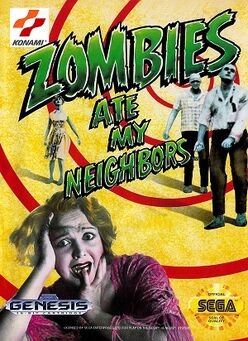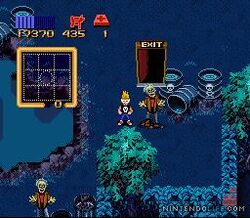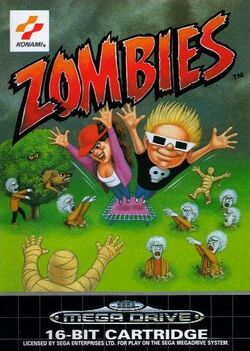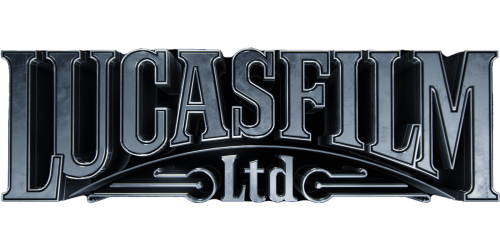| Zombies Ate My Neighbors | |
|---|---|

| |
| Developed by: | LucasArts |
| Published by: | Konami (SNES, Mega Drive/Genesis) LucasArts (Virtual Console) |
| Genre(s): | Run and gun |
Zombies Ate My Neighbors is a run and gun video game developed by LucasArts and originally published by Konami for the Super Nintendo and Sega Mega Drive/Sega Genesis consoles in 1993. One or two players take control of protagonists Zeke and Julie in order to rescue the titular neighbors from monsters often seen in horror movies. Aiding them in this task are a variety of weapons and power-ups that can be used to battle the numerous enemies in each level. Various elements and aspects of horror movies are referenced in the game with some of its more violent content being censored in various territories such as Europe and Australia, where it is known only as Zombies.
While not a massive commercial success, the game has been well received for its graphical style, humor and deep gameplay. It spawned a sequel, Ghoul Patrol, released in 1994. In 2009, Zombies Ate My Neighbors was re-released for the Virtual Console to positive reviews.
Gameplay[]

Zeke at the end of a level
The player chooses between two characters, Zeke and Julie, or both in a two-player mode. They navigate suburban neighborhoods, shopping malls, pyramids, haunted castles and other areas, destroying a variety of horror-movie monsters, including vampires, werewolves, huge demonic babies, squidmen, evil dolls, aliens, UFOs, giant ants, blobs, giant worms, and the game's namesake, zombies. In each of the 55 stages, which includes seven optional bonus levels, the goal is to rescue the surviving neighbors by touching them, at which point a door opens that will take the player to the next stage.[1] If the player does not find a neighbor fast enough, an enemy will kill them when touched, preventing them from being saved for the remainder of the game or until an "Extra Bonus Victim" is awarded. At least one neighbor must be saved from each level to progress to the next. The game is lost if the players lose all of their lives or if all of the neighbors are killed. Scoring points earns players neighbors to save and extra lives. Each level has at most ten neighbors, and each neighbor type is worth a different amount of points.
There are various items that the players can pick up along the way. These include keys that open up doors, health packs that restore health, and potions with various effects such as increasing speed or temporarily transforming the player into a powerful monster. Players can also collect various types of weapons, such as Uzi Water guns, bazookas, weed cutters, explosive soda cans, ice popsicles, tomatoes, silverware, plates, ancient crosses, fire extinguishers and martian bubble guns each with their own effectiveness against certain types of enemies.
Production[]
Zombies Ate My Neighbors was originally developed by LucasArts. It was published by Konami, a company already known for platformers in 1993.[2] Music for the game was composed by Joseph "Joe" McDermott. The ZAMN engine would later be used for Ghoul Patrol, Metal Warriors and Big Sky Trooper.[3] The developer wanted to include battery save in the game but was unable to as they could not afford it.[4]
The monsters in the game are based on classic horror films released in the 1950s and more modern films like Friday the 13th and The Texas Chain Saw Massacre.[5] Weapon effectiveness is also based on these depictions; werewolves die in one hit if attacked with silverware and vampires die faster if attacked with the crucifix. In the SNES version of the game, there's a flamethrower which is not included in the Sega Mega Drive version.[5] The North American release was released with a variant cover art in limited quantities.[citation needed]
Censorship[]

The PAL Sega Mega Drive release was renamed Zombies
The game's theme was subject to some censorship. This game was released before the ESRB inclusion and before then, Nintendo did not want violence in their video games. Nintendo of America ordered all depictions of blood and gore be removed or changed to purple ooze.[6]
Censorship committees in several European Nations—i.e. United Kingdom, Ireland, Italy, France, Spain, Austria, Portugal, Finland, Denmark, Norway, Sweden, Germany and Australia—censored more by having the game renamed to Zombies and ordered other changes including the replacement of the chainsaw-wielding enemies with lumberjacks wielding axes.[7]
Reception[]
| Reception | |
|---|---|
| Aggregate scores | |
| Aggregator | Score |
| GameRankings | 85.6%[8] |
| Review scores | |
| Publication | Score |
| Electronic Gaming Monthly | 9 out of 10[8] |
| IGN | 8 out of 10[9] |
| Nintendo Power | 3.8 out of 5[8] |
| Nintendo Life | 8 out of 10[1] |
| Sega-16.com | 8 out of 10[2] |
Although not an immediate success, Zombies Ate My Neighbors became a cult classic years after its release.[1][9] Upon its release, it got above average praise, earning a 85.6% on Gamerankings.com.[8] Reviewers of the game often cited its humor, two-player mode, graphics and music as some of its best aspects.
Mike Seiblier of Sega-16.com said the variety of weapons shows off the game's "tongue in cheek nature by giving you weapons and items like silverware, dishes, soda can grenades, a weed whacker, keys, bazookas as well as health packs."[2] The Armchair Empire similarly praised the variety and strategy that the weapon system incorporated. They also made note of the "little details that make it so cool to play", saying "If you come across a door, which you don't have the key for, you can blow it open with the bazooka."[10] Critics agreed the co-op mode is "highly recommended".[11]
The game's "colorful and detailed" graphics have been praised as well as its soundtrack which Seibler called an "homage to the spooky, over the top music found in old, scary flicks."[2] He went on to mention the sound effects are equally impressive. Corbie Dillard of Nintendolife.com said the graphics do not "exactly set new 16-bit standards, but they still manage to look sharp and the creative use of the darker color scheme used throughout the game really makes the creepy visuals come to life onscreen."[1] He ended his review by affectionately calling the game a "second-rate horror movie" version of Contra.
Upon the game's release for the Wii Virtual Console, Zombies Ate My Neighbors received immense praise and earned an Editor's Choice Award from IGN.[9] The game has been regarded as one of "the most requested additions to the VC system even before the Wii launch."[9][11] Comparisons to the game Dead Rising, released for the Xbox 360 in 2006, have been drawn, Lucas Thomas of IGN saying "Zombies Ate My Neighbors is basically a comical 16-bit template for the new Xbox 360 release, Dead Rising. And like that game, this one arms you with a pretty bizarre arsenal. Weed whackers, exploding soda cans and flying silverware all make an appearance to help you, or you and a friend, put a hurt on these living dead."[11] GameFAQs described the Xbox 360 game Monster Madness: Battle for Suburbia as "a tribute to the classic Zombies Ate My Neighbors" due to its similar gameplay, scenario, and B-Movie humor.[12]
Sequels and spin-offs[]
A sequel entitled Ghoul Patrol was released in 1994, but was not as well received as its predecessor. Originally, Ghoul Patrol was not intended to be released as a sequel to Zombies Ate My Neighbors, but was re-worked as such to increase sales. In 1997, LucasArts released a game for Sony's PlayStation and Sega's Sega Saturn titled Herc's Adventures, which uses the same basic gameplay format and mechanics as Zombies Ate My Neighbors, but instead parodies ancient Greek mythology. Maniac Mansion: Day of the Tentacle, another game developed by LucasArts, is referenced in Zombies Ate My Neighbors through a secret level.[13]
As of 2011, a film based on the game was in development.[14] The film is being penned and produced by screenwriter John Darko, known for his work on James Wan's Insidious[15] and Aaron Sims' Archetype. Story by unknown writer Mervin Luwee. At the time of report, the film was in the process of securing rights from LucasArts and obtaining a director as well as financing.[16]
References[]
- ↑ 1.0 1.1 1.2 1.3 Cite error: Invalid
<ref>tag; no text was provided for refs namedninlife - ↑ 2.0 2.1 2.2 2.3 Cite error: Invalid
<ref>tag; no text was provided for refs namedsega16 - ↑ Cite error: Invalid
<ref>tag; no text was provided for refs namedAutoHV-3 - ↑ http://www.hardcoregaming101.net/zamn/zamn1.htm
- ↑ 5.0 5.1 Cite error: Invalid
<ref>tag; no text was provided for refs namedaussie - ↑ Cite error: Invalid
<ref>tag; no text was provided for refs namedAutoHV-4 - ↑ Cite error: Invalid
<ref>tag; no text was provided for refs namedAutoHV-5 - ↑ 8.0 8.1 8.2 8.3 Cite error: Invalid
<ref>tag; no text was provided for refs namedGR - ↑ 9.0 9.1 9.2 9.3 Cite error: Invalid
<ref>tag; no text was provided for refs namedthomas - ↑ Cite error: Invalid
<ref>tag; no text was provided for refs namedarm - ↑ 11.0 11.1 11.2 Cite error: Invalid
<ref>tag; no text was provided for refs namedthomastwo - ↑ Cite error: Invalid
<ref>tag; no text was provided for refs namedAutoHV-6 - ↑ Cite error: Invalid
<ref>tag; no text was provided for refs namedAutoHV-7 - ↑ Cite error: Invalid
<ref>tag; no text was provided for refs namedAutoHV-8 - ↑ Cite error: Invalid
<ref>tag; no text was provided for refs namedAutoHV-9 - ↑ Plante, Chris (4 February 2012). "Zombies Ate My Neighbors" Movie Likely Stuck in Development Purgatory. Retrieved on November 3, 2012.
External links[]
- Zombies Ate My Neighbors at MobyGames
| This page uses content from the English Wikipedia. The original article was at Zombies Ate My Neighbors. The list of authors can be seen in the page history. As with Lucasfilm Wiki, the text of Wikipedia is available under the GNU Free Documentation License. |
